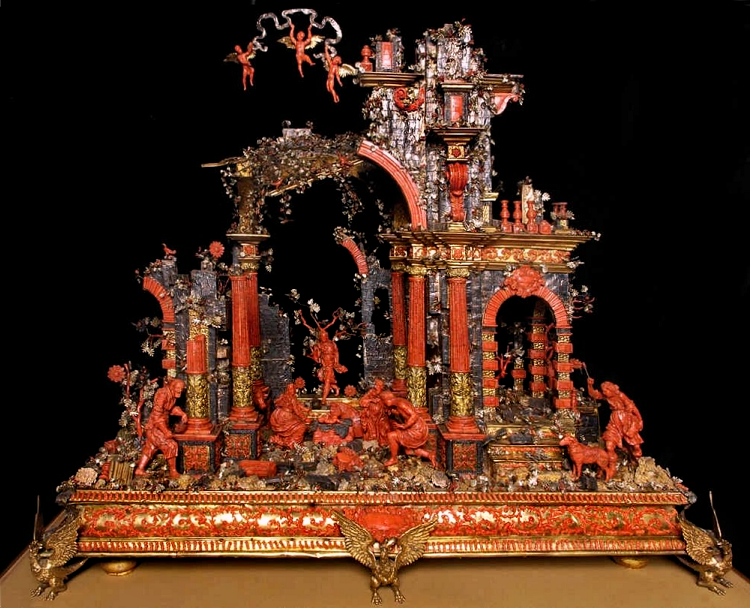 |
| (Detail of below.) |
For centuries the ancient fishing port of Trapani on the west coast of Sicily was renowned for its production of objects made from local red coral, carved - crudely or adroitly - or used in its natural branching form. From ancient times coral was thought to possess therapeutic properties, to cure infertility, to even ward off evil spirits and detect the presence of poison in food. It was therefore coveted for both religious and personal use and, beginning during the height of the Renaissance, much of the economy of Trapani grew to be based on the crafting - devotional imagery, jewelry,
objets d'art - of the precious material.
 |
| (Detail of above.) |
 |
| (Detail of above.) |



First noted as early as the twelfth century, the harvesting of the area's abundantly rich coral reefs began in earnest at the beginning of the fifteenth century, leading to the immigration of Jewish families from northwest Africa, who took to the processing and distribution of the coral to various markets in Italy. After the expulsions of the Jews at the end of the century, some who had converted remained and continued the work. Gradually there was a notable increase in the artisanship of the Trapani coral workers, from the creation of simple beads and balls and other small items, to the production of works - using more sophisticates techniques - of increasingly high artistic value, which reached its peak in the late seventeenth and eighteenth centuries.
 |
| (Detail of above.) |
 |
| (The following three images are details.) |





The most common forms from this period were capezzale, devotional plaques with religious figures set in engraved copper frames with coral inlay and enamel decoration. Other work included liturgical items such as chalices, candlesticks, and crucifixes. Most impressive were large, elaborate, free-standing tableaux, composed of hundreds of individual pieces. But secular objects like jewelry, inkstands, and small caskets were popular as well. The artistry of the Sicilian craftsmen was known far afield and eagerly collected all over Europe; Trapani coral work features prominently in the most lavish kunstkammern.
 |
| (Detail of above.) |
 |
| (The following three images are details.) |
Toward the end of the nineteenth century, changing tastes and - most importantly - the decline of raw materials in the Mediterranean had significantly affected the industry, eventually causing the near abandonment of the craft. In the last forty years or so, though, there has been something of a revival of the work, with young artists using traditional techniques to create fine jewelry and other objects, both religious and secular.







































Are the coral reefs depleted?
ReplyDeleteMy understanding is that there is much less of it - I don't have any specific data - but that it's still being harvested and used by the few artisans still working in the material.
DeleteLike red rubies of the seas. The Trapani Coral artistry is incredible.
ReplyDelete